Deposition of Biocompatible Polymers by 3D Printing (FDM) on Titanium Alloy
Abstract
1. Introduction
- (a)
- The introduction of new materials;
- (b)
- The application of a coating;
- (c)
- The modifcation of the surface layer;
- (d)
- The use of “soft” sliding materials.
2. Materials and Methods
- (a)
- Selection of 3D printing method;
- (b)
- Selection of metallic material;
- (c)
- Selection of biocompatible polymers;
- (d)
- Development of a method for application of a thermoplastic polymer to metal;
- (e)
- Adaptation of a 3D printer for application of a thermoplastic polymer to metal;
- (f)
- Preparation of the test stand to measure the destructive forces of polymer–metal bonds.
2.1. 3D Printing Method
- - FDM (fused deposition modeling);
- - SLA (stereolithography);
- - SLS/SLM (selective laser sintering/selective laser melting);
- - EBM (electron beam melting).
2.2. Metallic Material
2.3. Plastic Materials
2.4. Surface Roughness
- Adhesive interactions;
- Mechanical interactions.
- Ra < 0.5 µm (smooth surface);
- Ra > 5 µm (rough surface).
2.5. Shape of the Bond
- (1)
- The metal component can be placed in the printer workspace under the printer head (Figure 2a). This will allow the printer to apply plastic with standard movements without the danger of collision with the sample;
- (2)
- The printer’s nozzle can move next to the sample, meaning a collision with the sample may occur. In this case, it is necessary to develop custom software to determine the movements, so as to avoid collision with the specimen (Figure 2b).
2.6. Method of Manufacturing Metal–Polymer Components
- De-greasing the sample;
- Warming up the sample;
- Applying three layers of plastic;
- Stopping printing, turning off sample heating and cooling the sample to 60 °C (PLA) or 160 °C (PA);
- Resuming printing.
2.7. Testing of Metal–Polymer Bond
2.7.1. Tensile Strength Tests
2.7.2. Shear Strength Tests
2.7.3. Tribological Studies
- Tests for the coefficient of static friction µ0,
- Tests for the coefficient of kinetic friction µ.
- PLA–Ti6Al4V;
- PA–Ti6Al4V;
- Ti6Al4V–Ti6Al4V.
2.7.4. Microscopic Observations
3. Results
3.1. Results of Strength Tests
3.2. Results of Microscopic Observations
3.2.1. Ti6Al4V–PLA Bond
3.2.2. Ti6Al4V–PA Bond
3.3. Result of Tribological Tests
4. Discussion
4.1. Strenght Tests
- The deposition of the biocompatible material by 3D FDM printing on titanium alloy was possible; however, the rupture strength of the tested bonds was low. The prints made from PLA had a tensile strength range of about 20 to 80 MPa [74,75]. This range was very wide, since the mechanical properties of FDM 3D-printed element depend on numerous printing parameters. The sample printed with the same parameters as in this article had a strength value of 29 MPa. In terms of the 3D FDM-printed PA, the strength was approximately 33 MPa [76,77]. The obtained strength values for metal–polymer bonds did not exceed 2 MPa at tension and 3.5 MPa at shear. The rupture strength of the metal–plastic bond was much lower than the rupture strength of the weaker polymer material;
- The results of the strength tests showed expanded uncertainty (expanded uncertainty is up to 55% of the mean value). This means that the process of printing had low repeatability and the bonds were characterized by different rupture strengths;
- The usage of FDM 3D printing to deposit plastic as a part of the manufacturing process of endoprostheses would require an improvement, since the tensile and shear strength were too low and the repeatability of the printing process was poor;
- Ti6Al4V–PA bonds had 2–4 times lower tensile and shear strengths than Ti6Al4V–PLA;
- The effect of surface roughness on tensile strength was observed only for Ti6Al4V–PLA components. For samples with higher roughness, the tensile strength of the bonds was almost doubled. For shear strength, the effect of roughness was negligible.
4.2. Tribological Tests
- The friction pair Ti6Al4V–PA had the lowest coefficient of friction. The coefficient of friction values were low at 0.15 in terms of dry friction and 0.18 in presence of water. Seizure was not observed during the use of these materials. One of the most frequently used pairs in endoprostheses is an UHMWPE cup with a Ti6Al4V head. For such pairs, the coefficient of friction (dry friction) is in the range of 0.07–0.14 [86]. Hence, the coefficient of friction value of 0.15 for Ti6Al4V–PA was very good;
- The PLA–Ti6Al4V pair showed a significant coefficient of friction value of µ = 0.59. Therefore, PLA is not suitable for cooperation with titanium alloy in endoprostheses. PLA could be used as a material for scaffolds printed directly onto titanium alloy. Such scaffolds could be introduced in selected regions of the endoprosthesis to support tissue growth. Moreover, due to the biodegradability of PLA, the scaffold could be later removed from the patient’s body. The FDM method is well suited for creating scaffolds [87];
- The presence of water lowered the coefficient of friction values for most of the tested friction pairs. The Ti6Al4V–Ti6Al4V pair was an exception, since the coefficient of static friction in the presence of water was highest (µ 0 = 0.54);
- Ti6Al4V–PLA and Ti6Al4V–Ti6Al4V pairs had a tendency to seize. The addition of water reduced the coefficient of friction, although this effect was short-lived.
5. Conclusions
Author Contributions
Funding
Data Availability Statement
Conflicts of Interest
References
- Kirschner, P. Hüftendoprothetik. Der Chirurg. 2005, 76, 95–104. [Google Scholar] [CrossRef]
- Jamari, J.; Ammarullah, M.I.; Saad, A.P.M.; Syahrom, A.; Uddin, M.; van der Heide, E.; Basri, H. The Effect of Bottom Profile Dimples on the Femoral Head on Wear in Metal-on-Metal Total Hip Arthroplasty. J. Funct. Biomater. 2021, 12, 38. [Google Scholar] [CrossRef]
- Allen, Q.; Raeymaekers, B. Surface Texturing of Prosthetic Hip Implant Bearing Surfaces: A Review. J. Tribol. 2021, 143, 040801. [Google Scholar] [CrossRef]
- Qiblawey, Y.; Chowdhury, M.E.H.; Musharavati, F.; Zalnezhad, E.; Khandakar, A.; Islam, M.T. Instrumented Hip Implant: A Review. IEEE Sens. J. 2021, 21, 7179–7194. [Google Scholar] [CrossRef]
- Drescher, P.; Oldorf, P.; Dreier, T.; Peters, R.; Seitz, H. Modification of joint prosthesis surfaces by ultrashort pulse laser treatment for improved joint lubrication. Curr. Dir. Biomed. Eng. 2019, 5, 57–60. [Google Scholar] [CrossRef][Green Version]
- Arkhipov, S.V.; Skvortsov, D.V. Ligamentum Teres and its Analog in the Hip Endoprosthesis—Necessary or Superfluous? A Systematic Review. Muscle Ligaments Tendons J. 2021, 11, 301. [Google Scholar] [CrossRef]
- Sonntag, R.; Reinders, J.; Kretzer, J.P. Bio-Tribological Demands. In Materials for Total Joint Arthroplasty; Imperial College Press: London, UK, 2015; pp. 1–13. [Google Scholar]
- Jamróz, W.; Szafraniec, J.; Kurek, M.; Jachowicz, R. 3D printing in pharmaceutical and medical applications. Pharm. Res. 2018, 35, 176. [Google Scholar] [CrossRef] [PubMed]
- Javaid, M.; Haleem, A. Additive manufacturing applications in medical cases: A literature based review. Alex. J. Med. 2018, 54, 411–422. [Google Scholar] [CrossRef]
- Tack, P.; Victor, J.; Gemmel, P.; Annemans, L. 3D-printing techniques in a medical setting: A systematic literature review. Biomed. Eng. Online 2016, 15, 1–21. [Google Scholar] [CrossRef]
- Parthasarathy, J. 3D modeling, custom implants and its future perspectives in craniofacial surgery. Ann. Maxillofac. Surg. 2014, 4, 9–18. [Google Scholar] [CrossRef]
- Fan, H.; Fu, J.; Li, X.; Pei, Y.; Li, X.; Pei, G.; Guo, Z. Implantation of customized 3-D printed titanium prosthesis in limb salvage surgery: A case series and review of the literature. World J. Surg. Oncol. 2015, 13, 1–10. [Google Scholar] [CrossRef]
- Bagaria, V.; Bhansali, R.; Pawar, P. 3D printing-creating a blueprint for the future of orthopedics: Current concept review and the road ahead! J. Clin. Orthop. Trauma 2018, 9, 207–212. [Google Scholar] [CrossRef]
- Ji, T.; Guo, W. The evolution of pelvic endoprosthetic reconstruction after tumor resection. Ann. Jt. 2019, 4, 29. [Google Scholar] [CrossRef]
- Arabnejad, S.; Johnston, B.; Tanzer, M.; Pasini, D. Fully porous 3D printed titanium femoral stem to reduce stress-shielding following total hip arthroplasty. J. Orthop. Res. 2017, 35, 1774–1783. [Google Scholar] [CrossRef]
- Kuznetsov, V.E.; Tavitov, A.G.; Urzhumtsev, O.D.; Mikhalin, M.V.; Moiseev, A.I. Hardware Factors Influencing Strength of Parts Obtained by Fused Filament Fabrication. Polymers 2019, 11, 1870. [Google Scholar] [CrossRef]
- Syrlybayev, D.; Zharylkassyn, B.; Seisekulova, A.; Akhmetov, M.; Perveen, A.; Talamona, D. Optimisation of Strength Properties of FDM Printed Parts—A Critical Review. Polymers 2021, 13, 1587. [Google Scholar] [CrossRef]
- Martín, M.J.; Auñón, J.A.; Martín, F. Influence of Infill Pattern on Mechanical Behavior of Polymeric and Composites Specimens Manufactured Using Fused Filament Fabrication Technology. Polymers 2021, 13, 2934. [Google Scholar] [CrossRef] [PubMed]
- Bonada, J.; Pastor, M.M.; Buj-Corral, I. Influence of Infill Pattern on the Elastic Mechanical Properties of Fused Filament Fabrication (FFF) Parts through Experimental Tests and Numerical Analyses. Materials 2021, 14, 5459. [Google Scholar] [CrossRef]
- Kaur, G.; Singari, R.M.; Kumar, H. A review of fused filament fabrication (FFF): Process parameters and their impact on the tribological behavior of polymers (ABS). Mater. Today Proc. 2021. [Google Scholar] [CrossRef]
- Norani, M.N.M.; Abdollah, M.F.B.; Abdullah, M.I.H.C.; Amiruddin, H.; Ramli, F.R.; Tamaldin, N. Correlation of tribo-mechanical properties of internal geometry structures of fused filament fabrication 3D-printed acrylonitrile butadiene styrene. Ind. Lubr. Tribol. 2020, 72, 1259–1265. [Google Scholar] [CrossRef]
- Hanon, M.M.; Kovács, M.; Zsidai, L. Tribology behaviour investigation of 3D printed polymers. Int. Rev. Appl. Sci. Eng. 2019, 10, 173–181. [Google Scholar] [CrossRef]
- Prabhu, R.; Devaraju, A. Recent review of tribology, rheology of biodegradable and FDM compatible polymers. Mater. Today Proc. 2021, 39, 781–788. [Google Scholar] [CrossRef]
- Amirruddin, M.S.; Ismail, K.I.; Yap, T.C. Effect of layer thickness and raster angle on the tribological behavior of 3D printed materials. Mater. Today Proc. 2021. [Google Scholar] [CrossRef]
- Arif, M.F.; Alhashmi, H.; Varadarajan, K.M.; Koo, J.H.; Hart, A.J.; Kumar, S. Multifunctional performance of carbon nanotubes and graphene nanoplatelets reinforced PEEK composites enabled via FFF additive manufacturing. Compos. Part B Eng. 2020, 184, 107625. [Google Scholar] [CrossRef]
- Conference, I.; Pawlak, W. Wear and coefficient of friction of pla-graphite composite in 3D printing technology. Eng. Mech. 2018, 2018, 649–652. [Google Scholar] [CrossRef]
- Pawlak, W.; Kowalewski, P.; Przekop, R. On the tribological properties of polylactide (PLA) applied in 3D printing technology. Tribologia 2020, 289, 57–62. [Google Scholar] [CrossRef]
- Ladipo, T.L.; Masu, L.; Nziu, P. Solid Additives and their Lubrication Effects on Polyetheretherketone Polymers—A Review. Int. J. Eng. Res. Technol. 2020, 13, 4262–4268. [Google Scholar]
- Da Silva, D.; Kaduri, M.; Poley, M.; Adir, O.; Krinsky, N.; Shainsky-Roitman, J.; Schroeder, A. Biocompatibility, biodegradation and excretion of polylactic acid (PLA) in medical implants and theranostic systems. Chem. Eng. J. 2018, 340, 9–14. [Google Scholar] [CrossRef]
- Arif, M.F.; Kumar, S.; Varadarajan, K.M.; Cantwell, W.J. Performance of biocompatible PEEK processed by fused deposition additive manufacturing. Mater. Des. 2018, 146, 249–259. [Google Scholar] [CrossRef]
- Wu, H.; Fahy, W.P.; Kim, S.; Kim, H.; Zhao, N.; Pilato, L.; Kafi, A.; Bateman, S.; Koo, J.H. Recent developments in polymers/polymer nanocomposites for additive manufacturing. Prog. Mater. Sci. 2020, 111, 100638. [Google Scholar] [CrossRef]
- Zhang, X.; Chen, K.; Xu, L.; Qi, J.; Luo, Y.; Zhang, D. Tribological behavior of Ti6Al4 V alloy swing against UHMWPE under different lubrication. J. Thermoplast. Compos. Mater. 2019. [Google Scholar] [CrossRef]
- Wang, C.; Zhang, G.; Li, Z.; Zeng, X.; Xu, Y.; Zhao, S.; Hu, H.; Zhang, Y.; Ren, T. Tribological behavior of Ti-6Al-4V against cortical bone in different biolubricants. J. Mech. Behav. Biomed. Mater. 2019, 90, 460–471. [Google Scholar] [CrossRef] [PubMed]
- Nithyaprakash, R.; Shankar, S.; Santhosh, B.R.; Kumar, T.K.; Kiruba, P.; Srinivas, K.M. Tribological behavior of polyethylene and ceramic biomaterials under different bio-lubricants. Trends Biomater. Artif. Organs 2021, 35, 44–47. [Google Scholar]
- Araujo Borges, R.; Choudhury, D.; Zou, M. 3D printed PCU/UHMWPE polymeric blend for artificial knee meniscus. Tribol. Int. 2018, 122, 1–7. [Google Scholar] [CrossRef]
- Wang, X.; Zhao, L.; Fuh, J.Y.H.; Lee, H.P. Effect of Porosity on Mechanical Properties of 3D Printed Polymers: Experiments and Micromechanical Modeling Based on X-ray Computed Tomography Analysis. Polymers 2019, 11, 1154. [Google Scholar] [CrossRef] [PubMed]
- Buj-Corral, I.; Bagheri, A.; Sivatte-Adroer, M. Effect of Printing Parameters on Dimensional Error, Surface Roughness and Porosity of FFF Printed Parts with Grid Structure. Polymers 2021, 13, 1213. [Google Scholar] [CrossRef]
- Von Windheim, N.; Collinson, D.W.; Lau, T.; Brinson, L.C.; Gall, K. The influence of porosity, crystallinity and interlayer adhesion on the tensile strength of 3D printed polylactic acid (PLA). Rapid Prototyp. J. 2021, 27, 1327–1336. [Google Scholar] [CrossRef]
- Abar, B.; Alonso-Calleja, A.; Kelly, A.; Kelly, C.; Gall, K.; West, J.L. 3D printing of high-strength, porous, elastomeric structures to promote tissue integration of implants. J. Biomed. Mater. Res. Part A 2021, 109, 54–63. [Google Scholar] [CrossRef]
- Seok, J.M.; Rajangam, T.; Jeong, J.E.; Cheong, S.; Joo, S.M.; Oh, S.J.; Shin, H.; Kim, S.-H.; Park, S.A. Fabrication of 3D plotted scaffold with microporous strands for bone tissue engineering. J. Mater. Chem. B 2020, 8, 951–960. [Google Scholar] [CrossRef] [PubMed]
- Zhou, X.; Feng, Y.; Zhang, J.; Shi, Y.; Wang, L. Recent advances in additive manufacturing technology for bone tissue engineering scaffolds. Int. J. Adv. Manuf. Technol. 2020, 108, 3591–3606. [Google Scholar] [CrossRef]
- Luis, E.; Pan, H.M.; Bastola, A.K.; Bajpai, R.; Sing, S.L.; Song, J.; Yeong, W.Y. 3D printed silicone meniscus implants: Influence of the 3D printing process on properties of silicone implants. Polymers 2020, 12, 2136. [Google Scholar] [CrossRef]
- Masood, S.H.; Song, W.Q. Development of new metal/polymer materials for rapid tooling using Fused deposition modelling. Mater. Des. 2004, 25, 587–594. [Google Scholar] [CrossRef]
- Lambiase, F.; Di Ilio, A. Mechanical clinching of metal-polymer joints. J. Mater. Process. Technol. 2015, 215, 12–19. [Google Scholar] [CrossRef]
- Carradò, A.; Faerber, J.; Niemeyer, S.; Ziegmann, G.; Palkowski, H. Metal/polymer/metal hybrid systems: Towards potential formability applications. Compos. Struct. 2011, 93, 715–721. [Google Scholar] [CrossRef]
- Lambiase, F.; Scipioni, S.I.; Lee, C.J.; Ko, D.C.; Liu, F. A state-of-the-art review on advanced joining processes for metal-composite and metal-polymer hybrid structures. Materials 2021, 14, 1890. [Google Scholar] [CrossRef]
- Lambiase, F.; Grossi, V.; Paoletti, A. High-speed joining of hybrid metal-polymer joints during the friction-assisted joining process. Compos. Struct. 2022, 280, 114890. [Google Scholar] [CrossRef]
- Bula, K.; Sterzyński, T.; Piasecka, M.; Rózański, L. Deformation mechanism in mechanically coupled polymer-metal hybrid joints. Materials 2020, 13, 2512. [Google Scholar] [CrossRef]
- Ghiya, R.; Badheka, V.J. A review of friction stir lap welding of polymer to metal. Polym. Technol. Mater. 2021, 60, 1966–1995. [Google Scholar] [CrossRef]
- Liu, F.C.; Dong, P.; Pei, X. A high-speed metal-to-polymer direct joining technique and underlying bonding mechanisms. J. Mater. Process. Technol. 2020, 280, 116610. [Google Scholar] [CrossRef]
- Ozlati, A.; Movahedi, M.; Tamizi, M.; Tartifzadeh, Z.; Alipour, S. An alternative additive manufacturing-based joining method to make Metal/Polymer hybrid structures. J. Manuf. Process. 2019, 45, 217–226. [Google Scholar] [CrossRef]
- Zou, X.; Huang, L.; Chen, K.; Jiang, M.; Zhang, S.; Wang, M.; Hua, X.; Shan, A. Surface structuring via additive manufacturing to improve the performance of metal and polymer joints. Metals 2021, 11, 567. [Google Scholar] [CrossRef]
- Siemiński, P.; Budzik, G. Techniki Przyrostowe. Druk 3D. Drukarki 3D; Oficyna Wydawnicza Politechniki Warszawskiej: Warsaw, Poland, 2015. [Google Scholar]
- Rahim, T.N.A.T.; Abdullah, A.M.; Akil, H. Recent Developments in Fused Deposition Modeling-Based 3D Printing of Polymers and Their Composites. Polym. Rev. 2019, 59, 589–624. [Google Scholar] [CrossRef]
- Cui, C.; Hu, B.; Zhao, L.; Liu, S. Titanium alloy production technology, market prospects and industry development. Mater. Des. 2011, 32, 1684–1691. [Google Scholar] [CrossRef]
- Moiduddin, K.; Mian, S.H.; Umer, U.; Alkhalefah, H. Fabrication and Analysis of a Ti6Al4V Implant for Cranial Restoration. Appl. Sci. 2019, 9, 2513. [Google Scholar] [CrossRef]
- Al Kindi, M.N.; Moiduddin, K.; Al-Ahmari, A.; Nasr, E.S.A.; Ramalingam, S.; Badwelan, M. Functional and aesthetic outcomes of electron beam-melted titanium reconstruction plates: An in vivo goat study. Biomed. Res. 2017, 28, 2073–2080. [Google Scholar]
- Lee, J.-W.; Fang, J.-J.; Chang, L.-R.; Yu, C.-K. Mandibular Defect Reconstruction with the Help of Mirror Imaging Coupled with Laser Stereolithographic Modeling Technique. J. Formos. Med. Assoc. 2007, 106, 244–250. [Google Scholar] [CrossRef]
- Nath, S.D.; Nilufar, S. An Overview of Additive Manufacturing of Polymers and Associated Composites. Polymers 2020, 12, 2719. [Google Scholar] [CrossRef]
- Przekop, R.E.; Kujawa, M.; Pawlak, W.; Dobrosielska, M.; Sztorch, B.; Wieleba, W. Graphite Modified Polylactide (PLA) for 3D Printed (FDM/FFF) Sliding Elements. Polymers 2020, 12, 1250. [Google Scholar] [CrossRef]
- Singh, D.; Singh, R.; Boparai, K.S. Development and surface improvement of FDM pattern based investment casting of biomedical implants: A state of art review. J. Manuf. Process. 2018, 31, 80–95. [Google Scholar] [CrossRef]
- Schirmeister, C.G.; Hees, T.; Licht, E.H.; Mülhaupt, R. 3D printing of high density polyethylene by fused filament fabrication. Addit. Manuf. 2019, 28, 152–159. [Google Scholar] [CrossRef]
- Wong, K.C. 3D-printed patient-specific applications in orthopedics. Orthop. Res. Rev. 2016, 8, 57–66. [Google Scholar] [CrossRef]
- Khalil, Y.; Hopkinson, N.; Kowalski, A.; Fairclough, J.P.A. Characterisation of UHMWPE polymer powder for laser sintering. Materials 2019, 12, 3496. [Google Scholar] [CrossRef] [PubMed]
- Z-PLA Technical Data Sheet. Available online: https://cf.zortrax.com/wp-content/uploads/2018/06/Z-PLA_Technical_Data_Sheet_eng-1.pdf (accessed on 10 November 2021).
- Z-NYLON Technical Data Sheet. Available online: https://cf.zortrax.com/wp-content/uploads/2018/11/Z-NYLON_Technical_Data_Sheet_eng-2.pdf (accessed on 10 November 2021).
- Kujawa, M. The influence of first layer parameters on adhesion between the 3D printer’s glass bed and ABS. In Interdyscyplinarność Badań Naukowych; Oficyna Wydawnicza Politechniki Wrocławskiej: Wrocław, Poland, 2017; pp. 76–81. [Google Scholar]
- Zhu, K.; Deng, Z.; Dai, S.; Yu, Y. Temperature-compensated constitutive model of fused filament fabrication 3D printed PLA materials with full extrusion temperatures. Rapid Prototyp. J. 2021, 28, 41–51. [Google Scholar] [CrossRef]
- Vanaei, H.R.; Shirinbayan, M.; Vanaei, S.; Fitoussi, J.; Khelladi, S.; Tcharkhtchi, A. Multi-scale damage analysis and fatigue behavior of PLA manufactured by fused deposition modeling (FDM). Rapid Prototyp. J. 2021, 27, 371–378. [Google Scholar] [CrossRef]
- Arifvianto, B.; Wirawan, Y.B.; Salim, U.A.; Suyitno, S.; Mahardika, M. Effects of extruder temperatures and raster orientations on mechanical properties of the FFF-processed polylactic-acid (PLA) material. Rapid Prototyp. J. 2021, 27, 1761–1775. [Google Scholar] [CrossRef]
- Calignano, F.; Lorusso, M.; Roppolo, I.; Minetola, P. Investigation of the Mechanical Properties of a Carbon Fibre-Reinforced Nylon Filament for 3D Printing. Machines 2020, 8, 52. [Google Scholar] [CrossRef]
- El Magri, A.; Vanaei, S.; Shirinbayan, M.; Vaudreuil, S.; Tcharkhtchi, A. An Investigation to Study the Effect of Process Parameters on the Strength and Fatigue Behavior of 3D-Printed PLA-Graphene. Polymers 2021, 13, 3218. [Google Scholar] [CrossRef]
- Vanaei, H.R.; Shirinbayan, M.; Deligant, M.; Khelladi, S.; Tcharkhtchi, A. In-Process Monitoring of Temperature Evolution during Fused Filament Fabrication: A Journey from Numerical to Experimental Approaches. Thermo 2021, 1, 332–360. [Google Scholar] [CrossRef]
- Kuznetsov, V.; Solonin, A.; Urzhumtsev, O.; Schilling, R.; Tavitov, A. Strength of PLA Components Fabricated with Fused Deposition Technology Using a Desktop 3D Printer as a Function of Geometrical Parameters of the Process. Polymers 2018, 10, 313. [Google Scholar] [CrossRef]
- Hsueh, M.-H.; Lai, C.-J.; Chung, C.-F.; Wang, S.-H.; Huang, W.-C.; Pan, C.-Y.; Zeng, Y.-S.; Hsieh, C.-H. Effect of Printing Parameters on the Tensile Properties of 3D-Printed Polylactic Acid (PLA) Based on Fused Deposition Modeling. Polymers 2021, 13, 2387. [Google Scholar] [CrossRef]
- Tate, J.S.; Brushaber, R.P.; Danielsen, E.; Kallagunta, H.; Navale, S.V.; Arigbabowo, O.; Shree, S.; Yaseer, A. Electrical and mechancial properties of fused filament fabrication of polyamide 6/nanographene filaments at different annealing temperatures. In Proceedings of the 30th Annual International Solid Freeform Fabrication Symposium—An Additive Manufacturing Conference, Austin, TX, USA, 12–14 August 2019; 2019; pp. 1008–1021. Available online: https://utw10945.utweb.utexas.edu/sites/default/files/2019/088%20Electrical%20and%20Mechancial%20Properties%20of%20Fused%20Fila.pdf (accessed on 10 November 2021).
- Abdullah, A.M.; Tuan Rahim, T.N.A.; Mohamad, D.; Akil, H.M.; Rajion, Z.A. Mechanical and physical properties of highly ZrO2 /β-TCP filled polyamide 12 prepared via fused deposition modelling (FDM) 3D printer for potential craniofacial reconstruction application. Mater. Lett. 2017, 189, 307–309. [Google Scholar] [CrossRef]
- Jordá-Vilaplana, A.; Fombuena, V.; García-García, D.; Samper, M.D.; Sánchez-Nácher, L. Surface modification of polylactic acid (PLA) by air atmospheric plasma treatment. Eur. Polym. J. 2014, 58, 23–33. [Google Scholar] [CrossRef]
- Novák, I.; Števiar, M.; Chodák, I. Surface Energy and Adhesive Properties of Polyamide 12 Modified by Barrier and Radio-Frequency Discharge Plasma. Mon. Chem.-Chem. Mon. 2006, 137, 943–952. [Google Scholar] [CrossRef]
- McNally, T.; Raymond Murphy, W.; Lew, C.Y.; Turner, R.J.; Brennan, G.P. Polyamide-12 layered silicate nanocomposites by melt blending. Polymer 2003, 44, 2761–2772. [Google Scholar] [CrossRef]
- Lim, L.-T.; Auras, R.; Rubino, M. Processing technologies for poly(lactic acid). Prog. Polym. Sci. 2008, 33, 820–852. [Google Scholar] [CrossRef]
- Lay, M.; Thajudin, N.L.N.; Hamid, Z.A.A.; Rusli, A.; Abdullah, M.K.; Shuib, R.K. Comparison of physical and mechanical properties of PLA, ABS and nylon 6 fabricated using fused deposition modeling and injection molding. Compos. Part B Eng. 2019, 176, 107341. [Google Scholar] [CrossRef]
- Godec, D.; Cano, S.; Holzer, C.; Gonzalez-Gutierrez, J. Optimization of the 3D Printing Parameters for Tensile Properties of Specimens Produced by Fused Filament Fabrication of 17-4PH Stainless Steel. Materials 2020, 13, 774. [Google Scholar] [CrossRef]
- Bochnia, J.; Blasiak, M.; Kozior, T. A Comparative Study of the Mechanical Properties of FDM 3D Prints Made of PLA and Carbon Fiber-Reinforced PLA for Thin-Walled Applications. Materials 2021, 14, 7062. [Google Scholar] [CrossRef]
- Yan, R.; Wang, Y.; Luo, P.; Li, Y.; Lu, X. Fused filament fabrication of continuous optic fiber reinforced polylactic acid composites. Rapid Prototyp. J. 2021. [Google Scholar] [CrossRef]
- Sobociński, M. Analysis of friction and lubrication of human joint’s surfaces. J. Appl. Math. Comput. Mech. 2016, 15, 161–167. [Google Scholar] [CrossRef]
- Okolie, O.; Stachurek, I.; Kandasubramanian, B.; Njuguna, J. 3D Printing for Hip Implant Applications: A Review. Polymers 2020, 12, 2682. [Google Scholar] [CrossRef] [PubMed]
- Terekhina, S.; Tarasova, T.; Egorov, S.; Guillaumat, L.; Hattali, M.L. On the difference in material structure and fatigue properties of polyamide specimens produced by fused filament fabrication and selective laser sintering. Int. J. Adv. Manuf. Technol. 2020, 111, 93–107. [Google Scholar] [CrossRef]
- Liao, Y.; Liu, C.; Coppola, B.; Barra, G.; Di Maio, L.; Incarnato, L.; Lafdi, K. Effect of Porosity and Crystallinity on 3D Printed PLA Properties. Polymers 2019, 11, 1487. [Google Scholar] [CrossRef] [PubMed]
- Al-Maharma, A.Y.; Patil, S.P.; Markert, B. Effects of porosity on the mechanical properties of additively manufactured components: A critical review. Mater. Res. Express 2020, 7, 122001. [Google Scholar] [CrossRef]

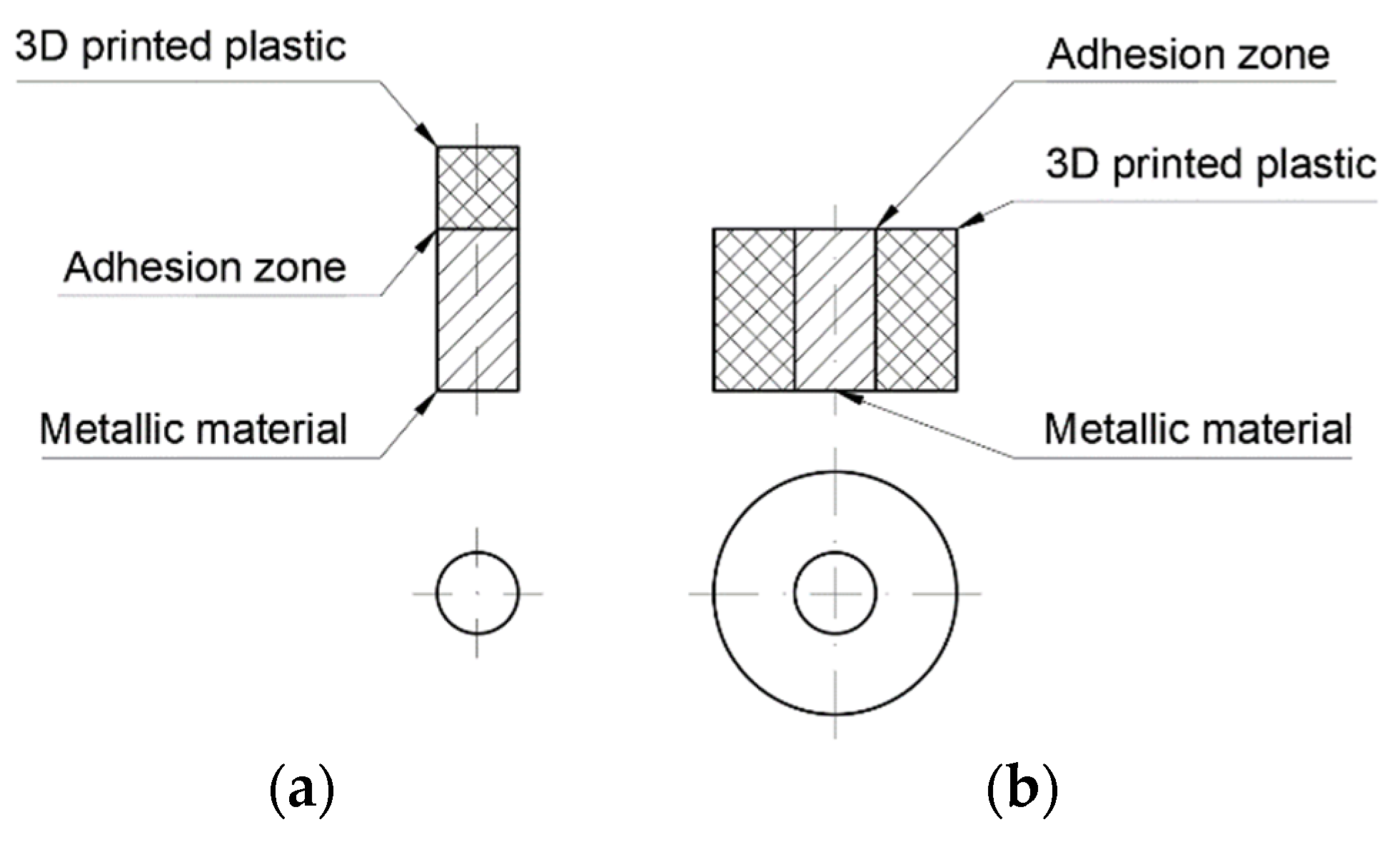


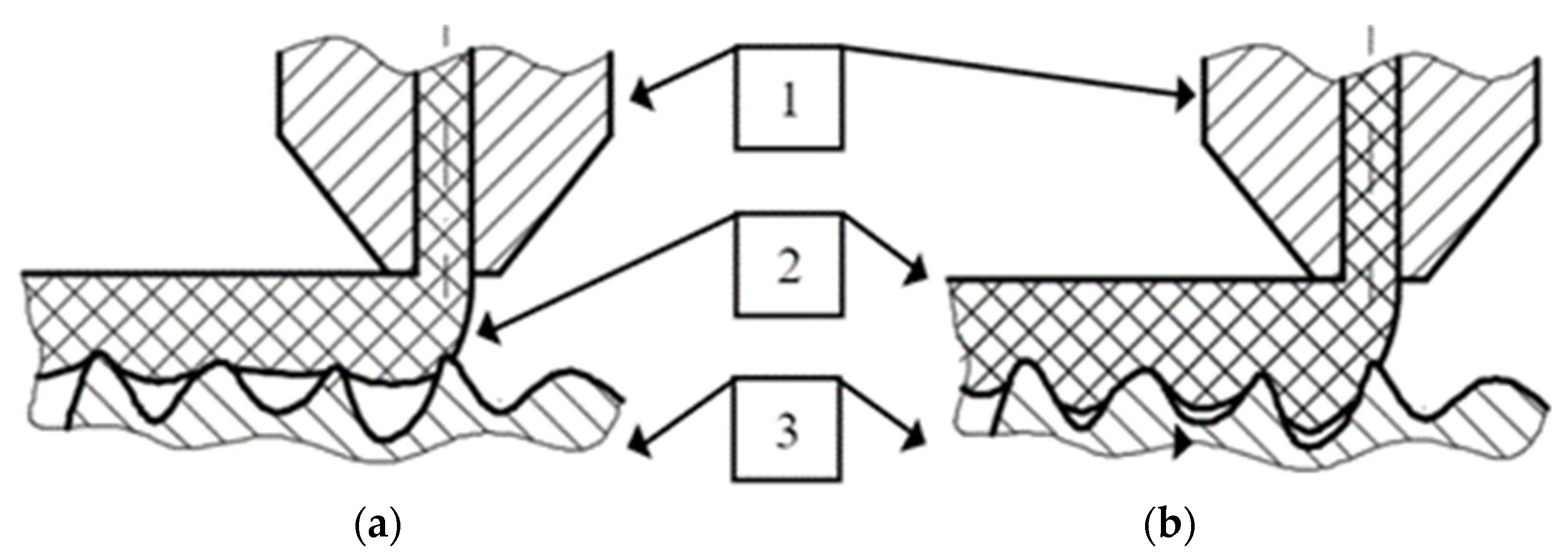
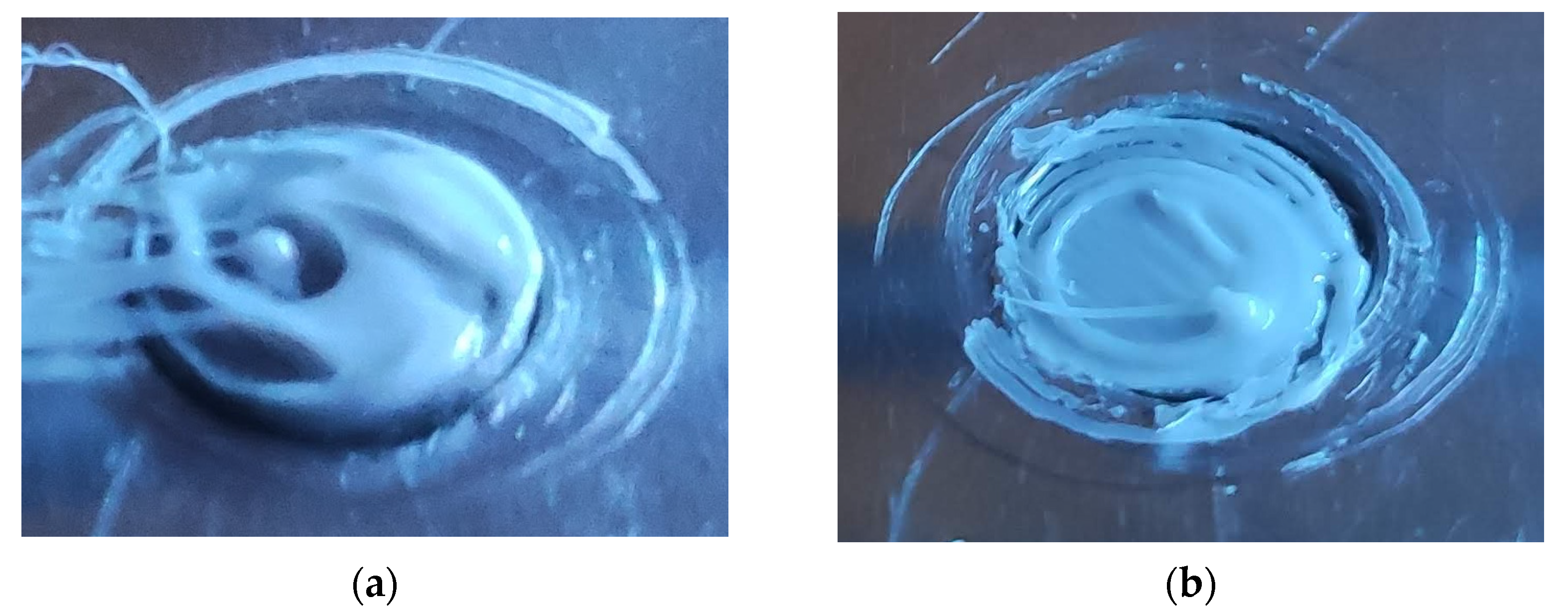
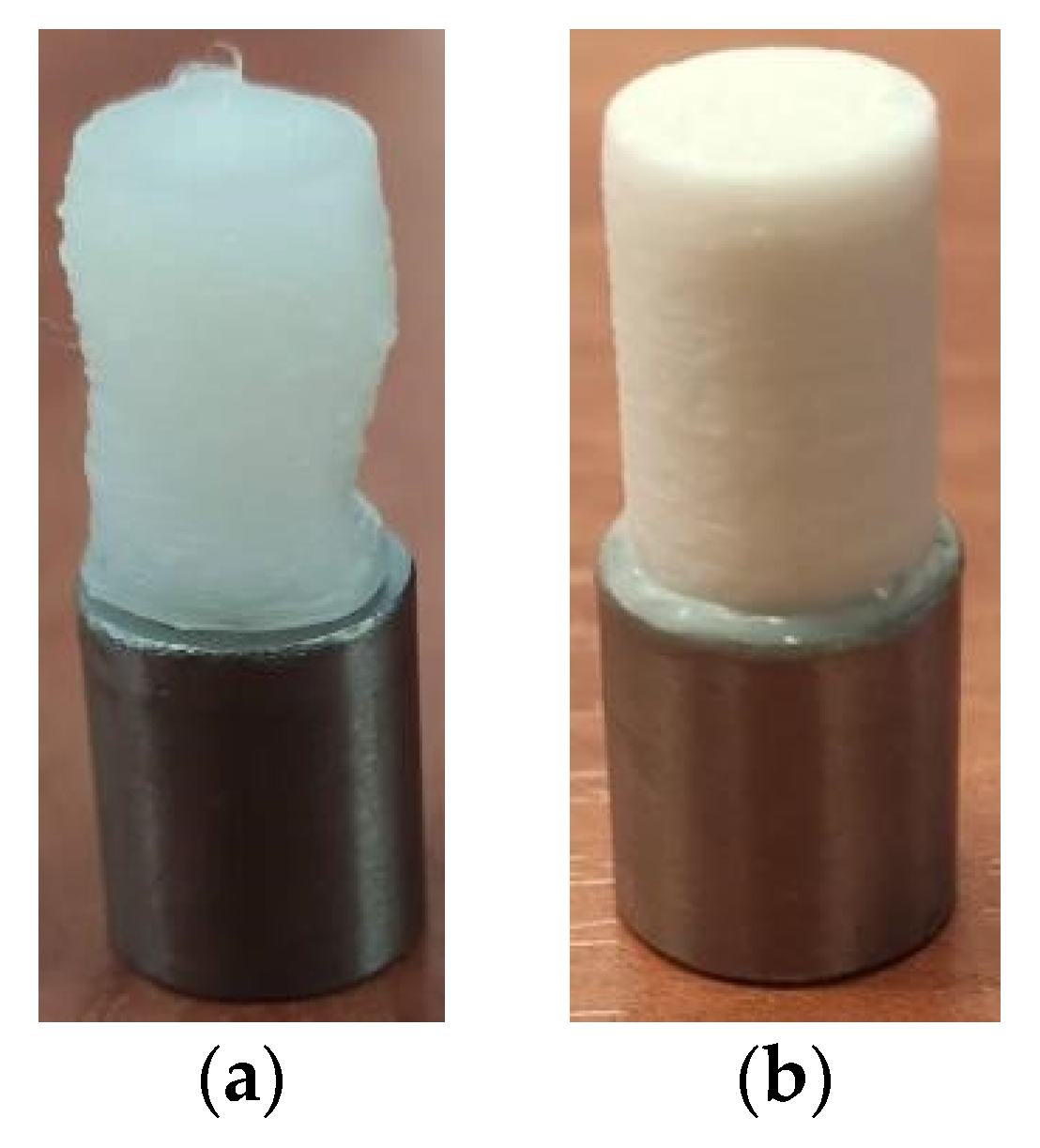

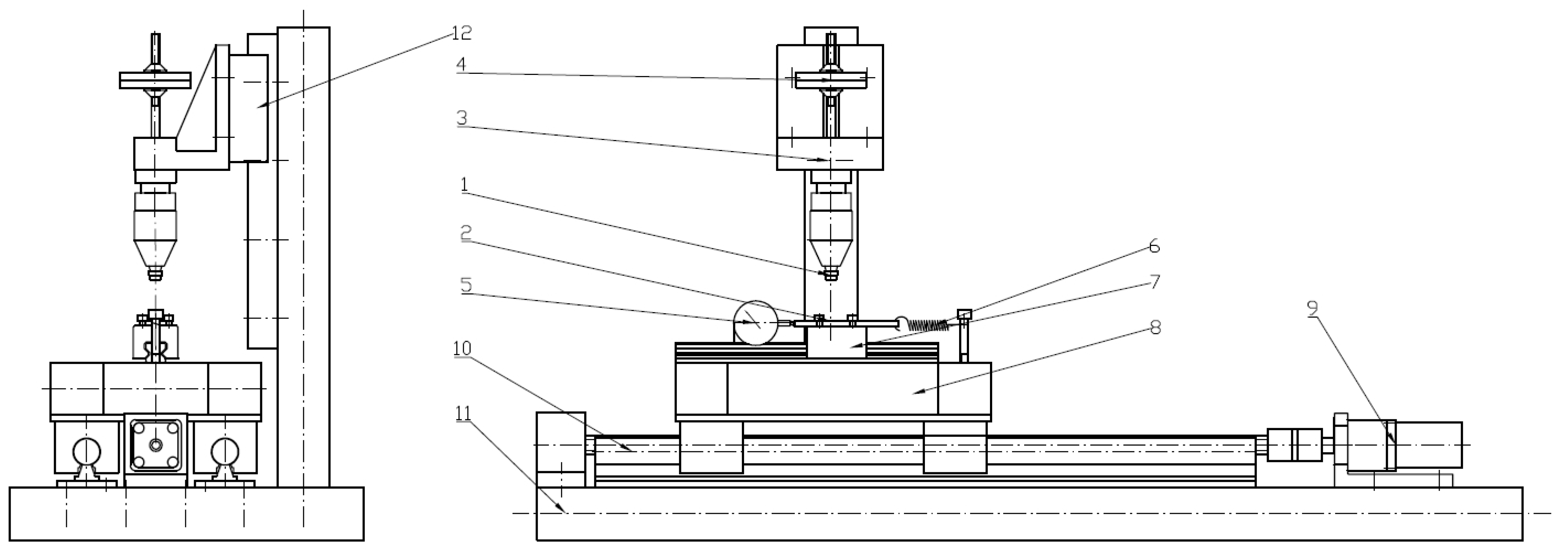



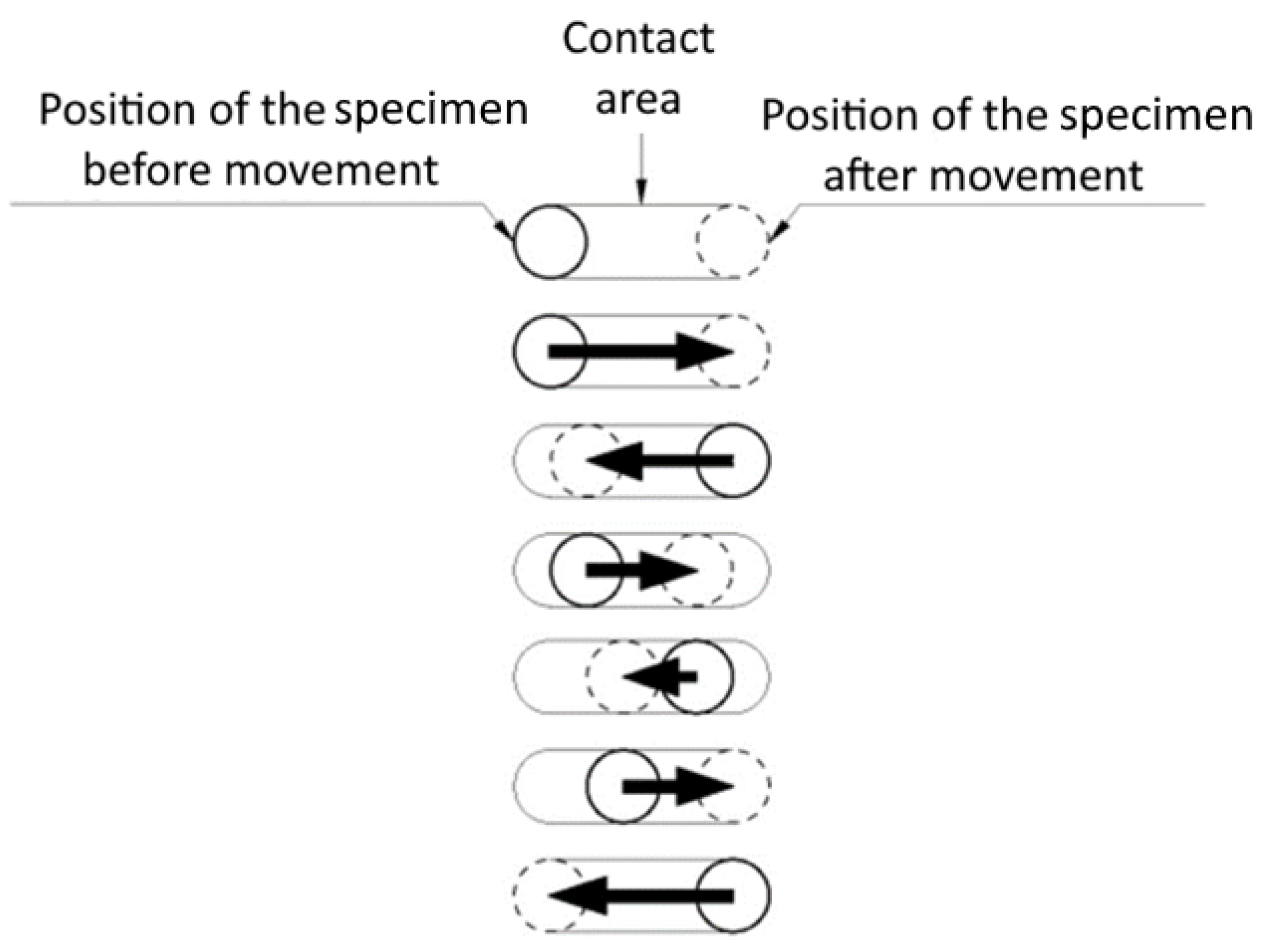


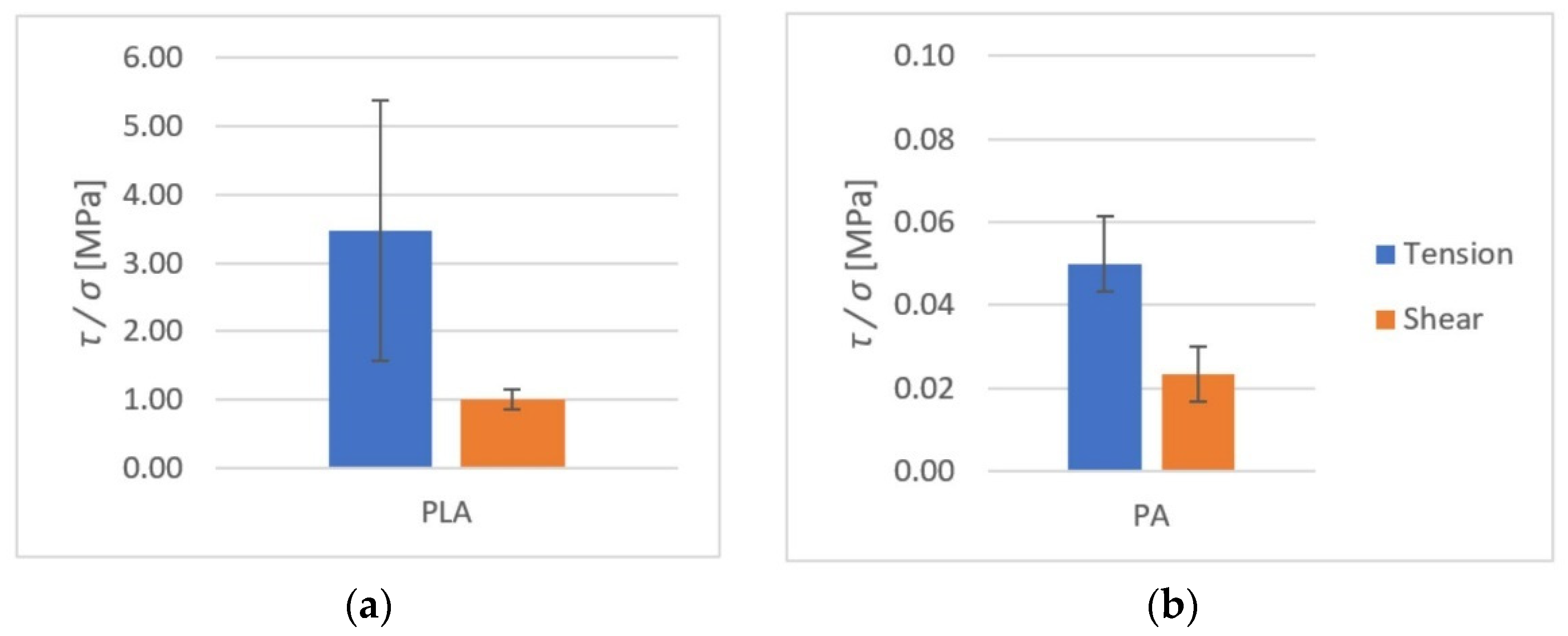


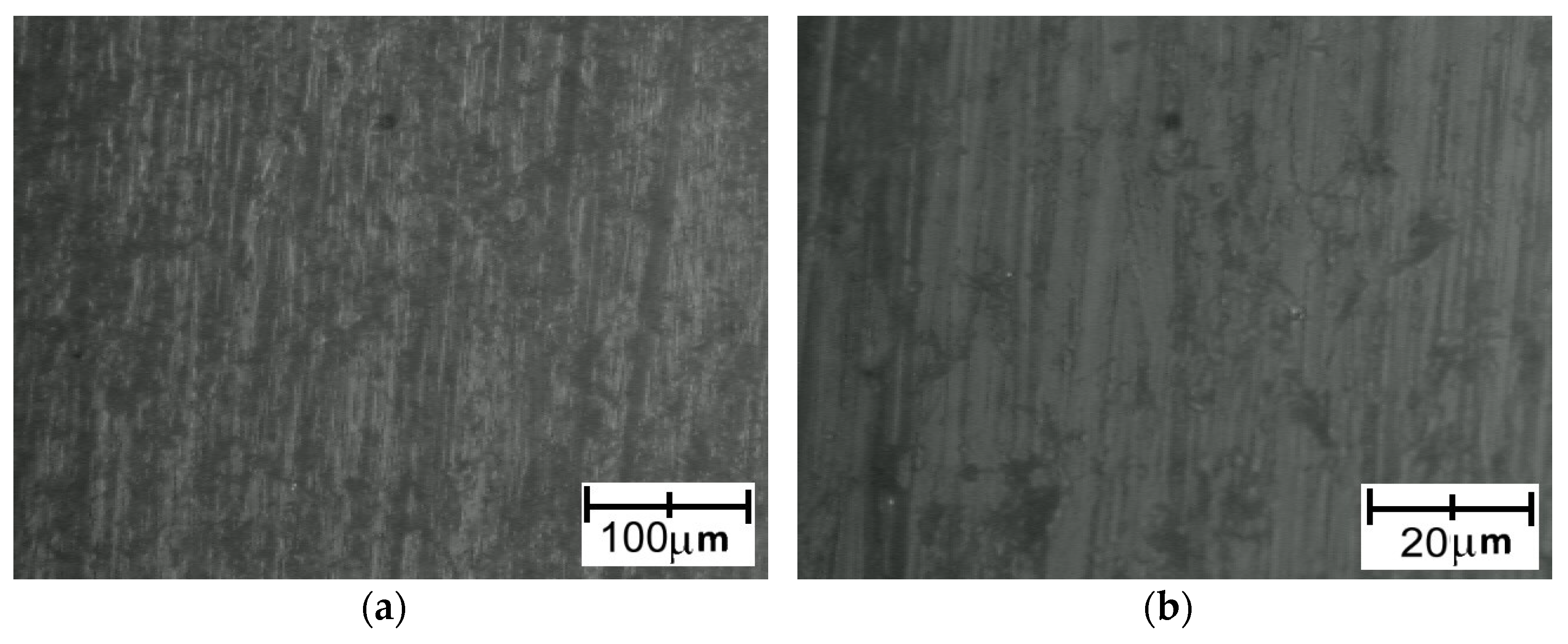
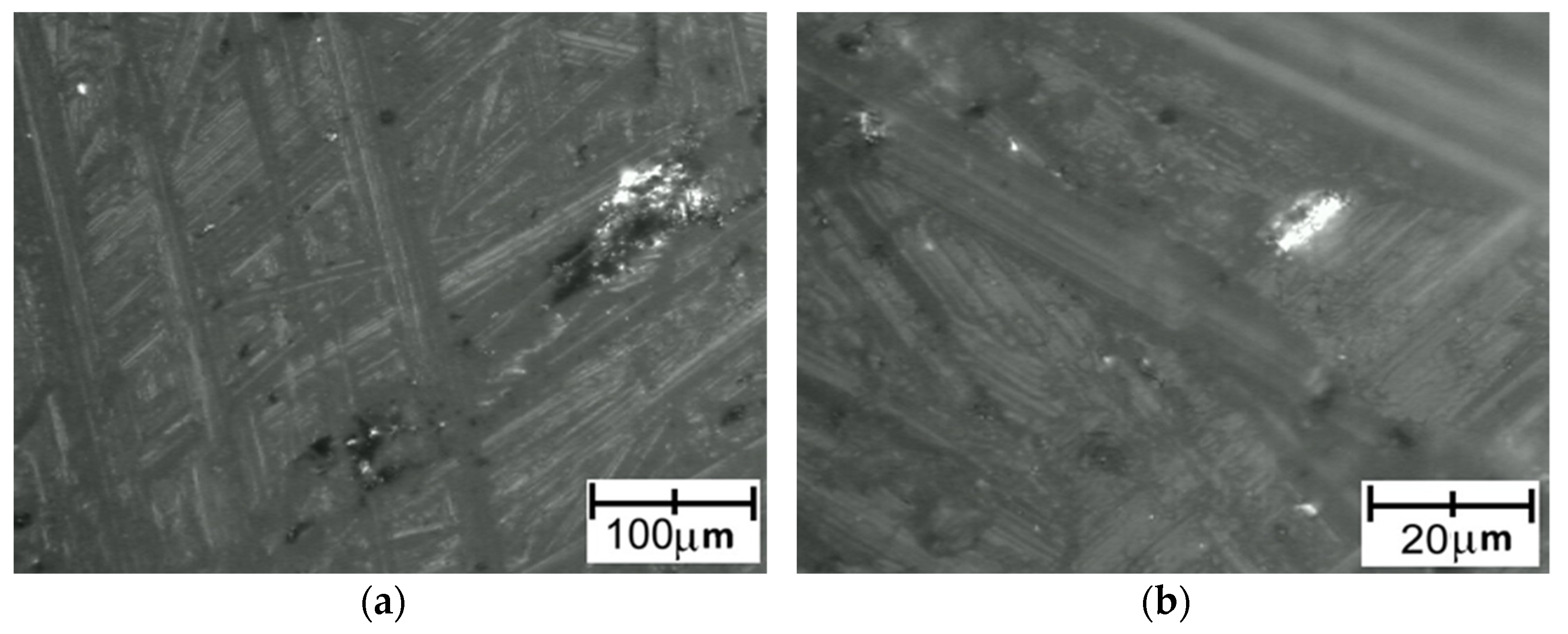


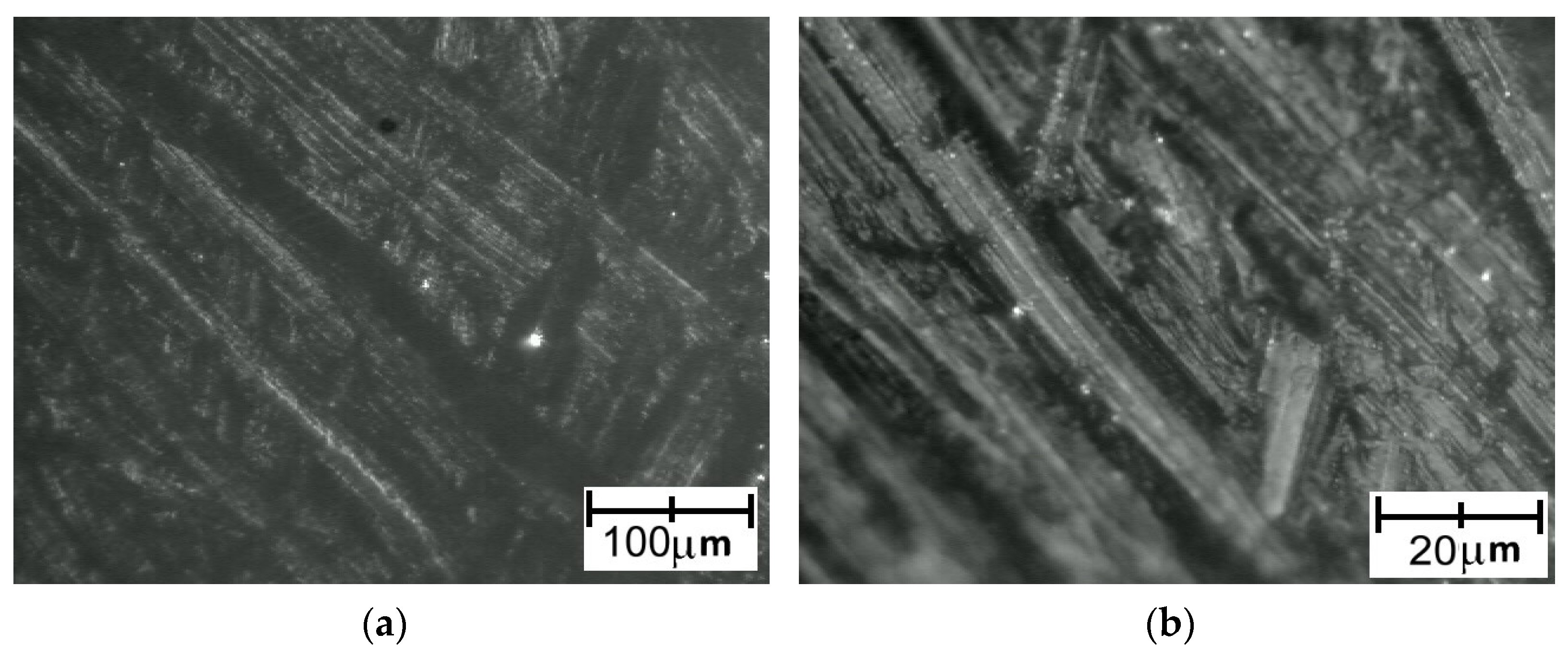
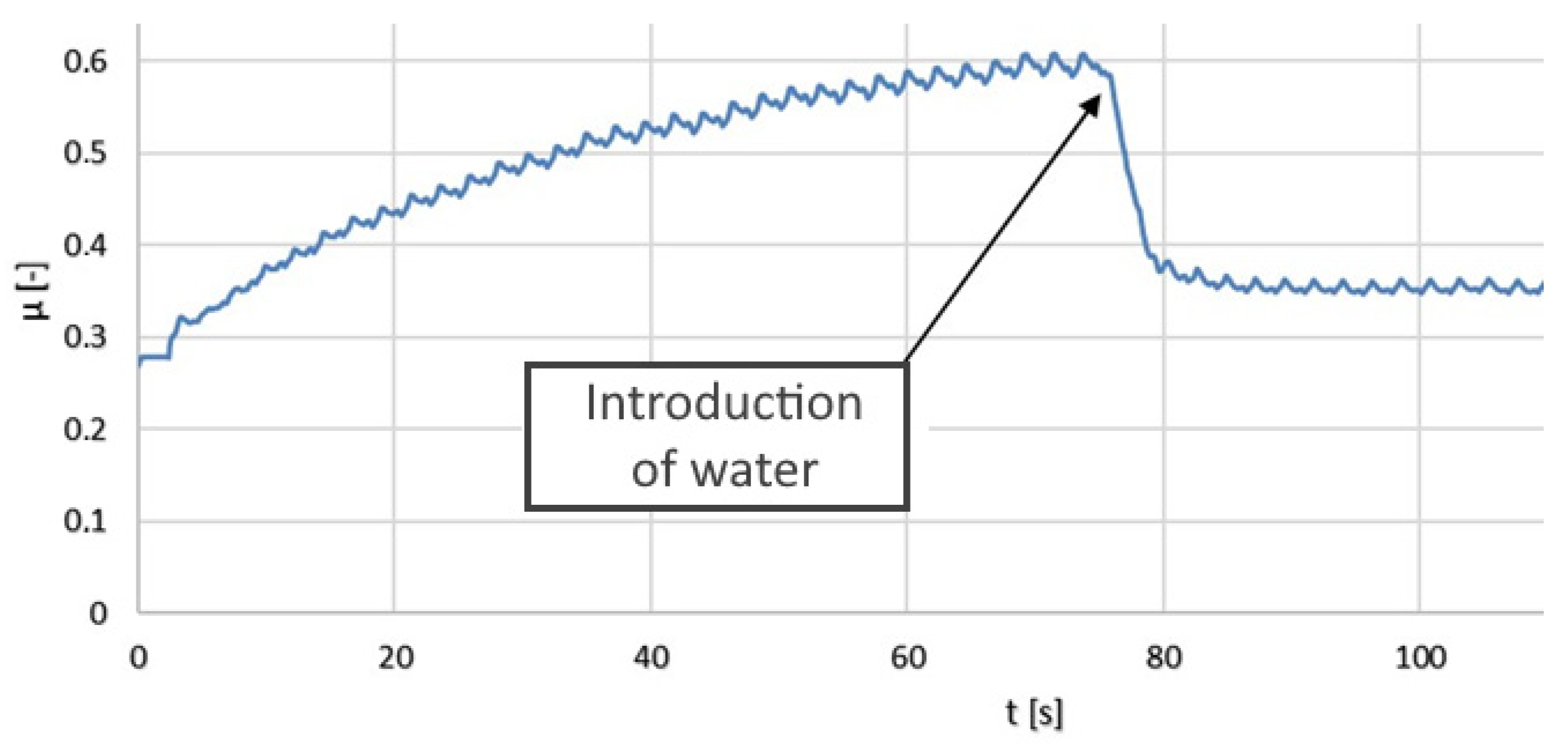
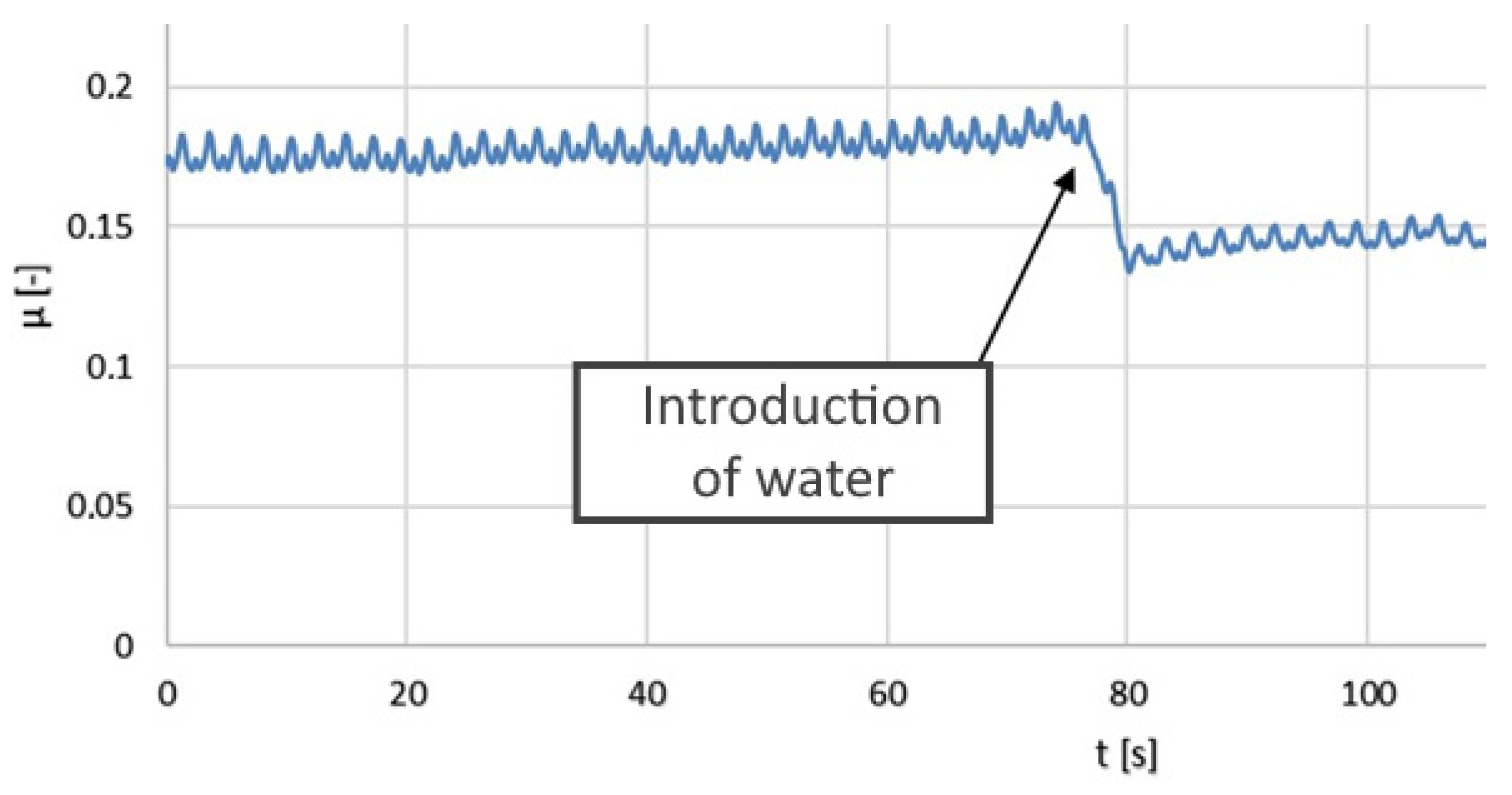
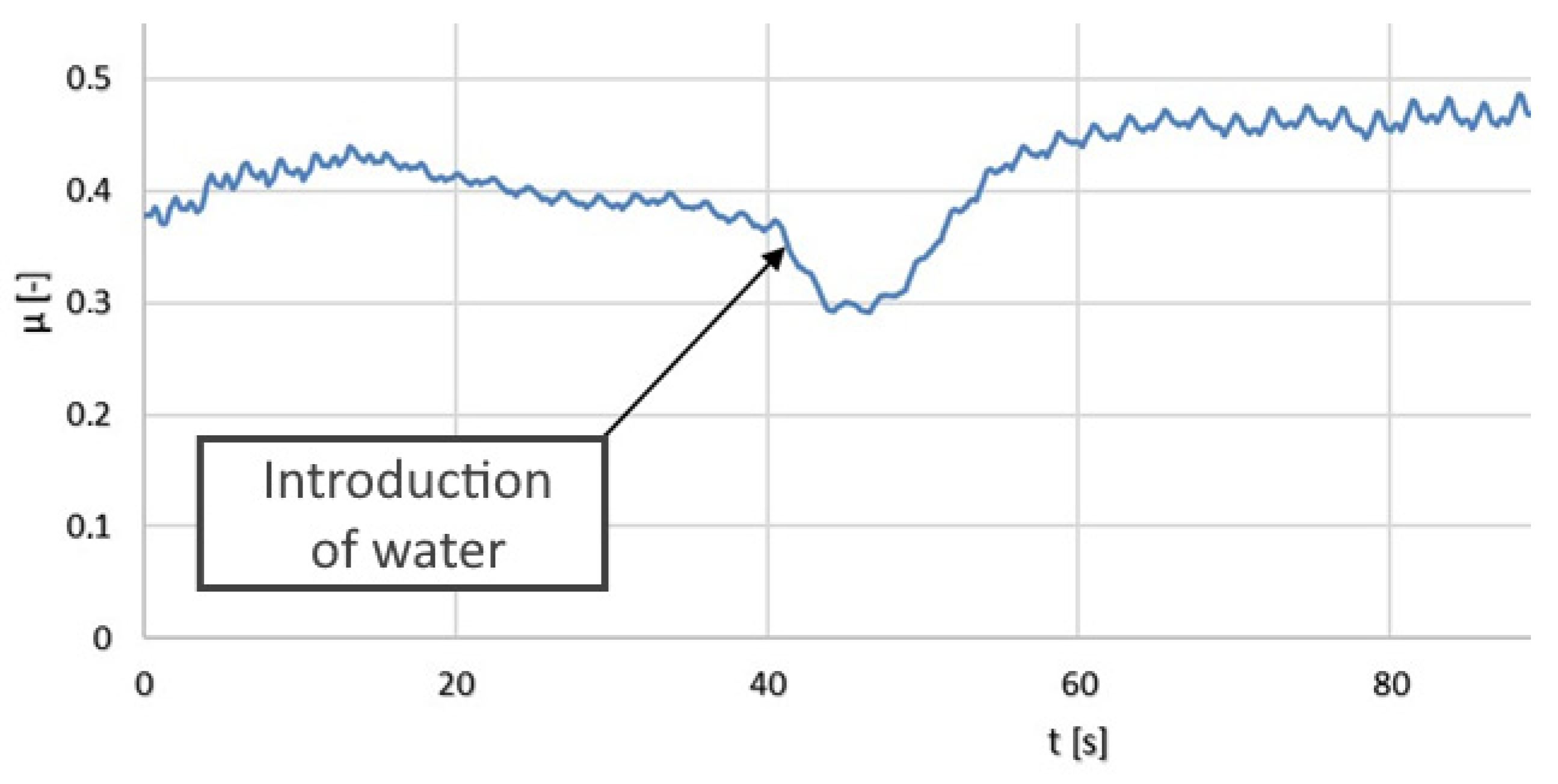
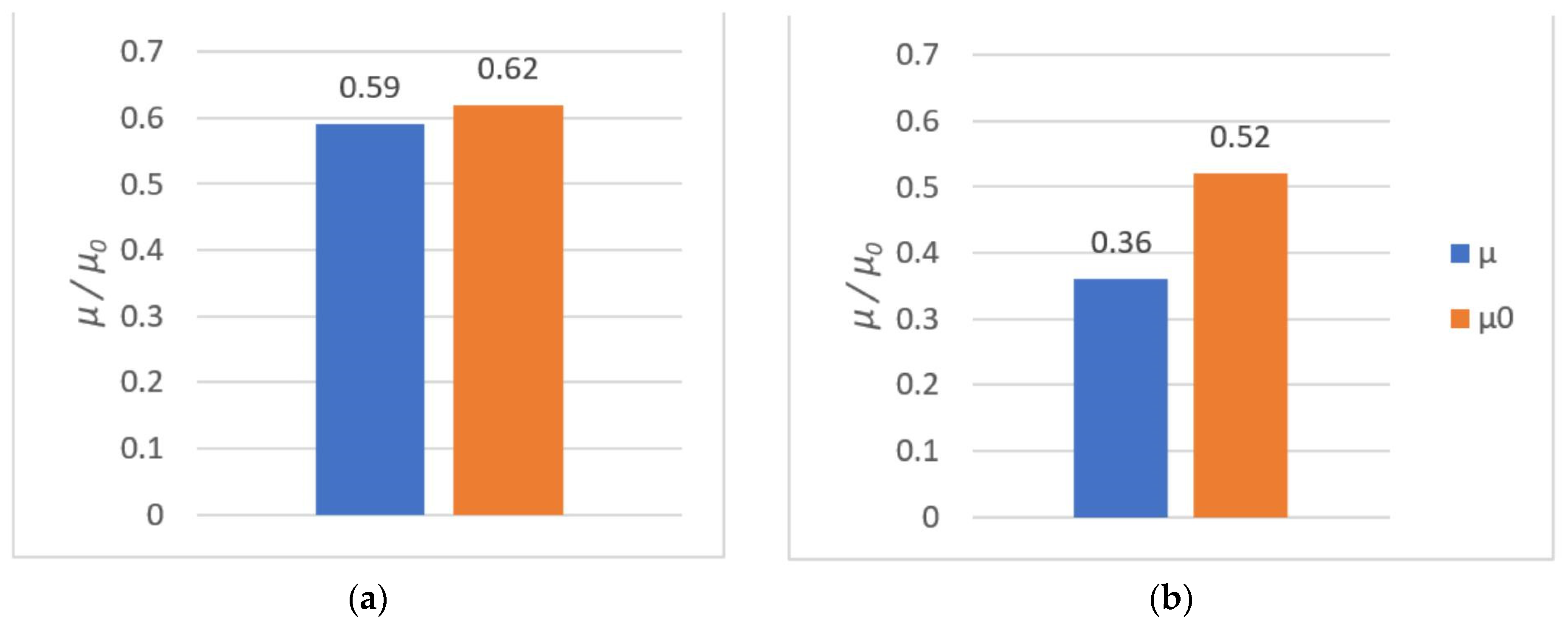
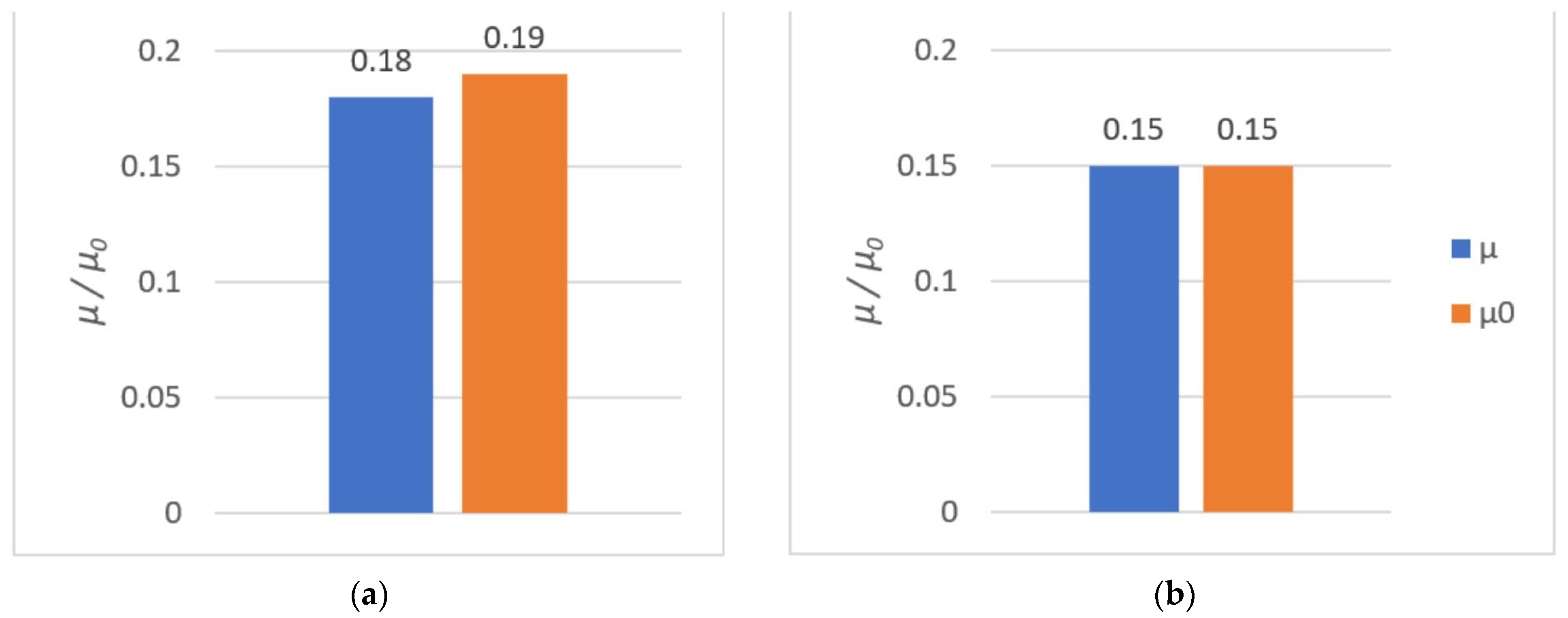
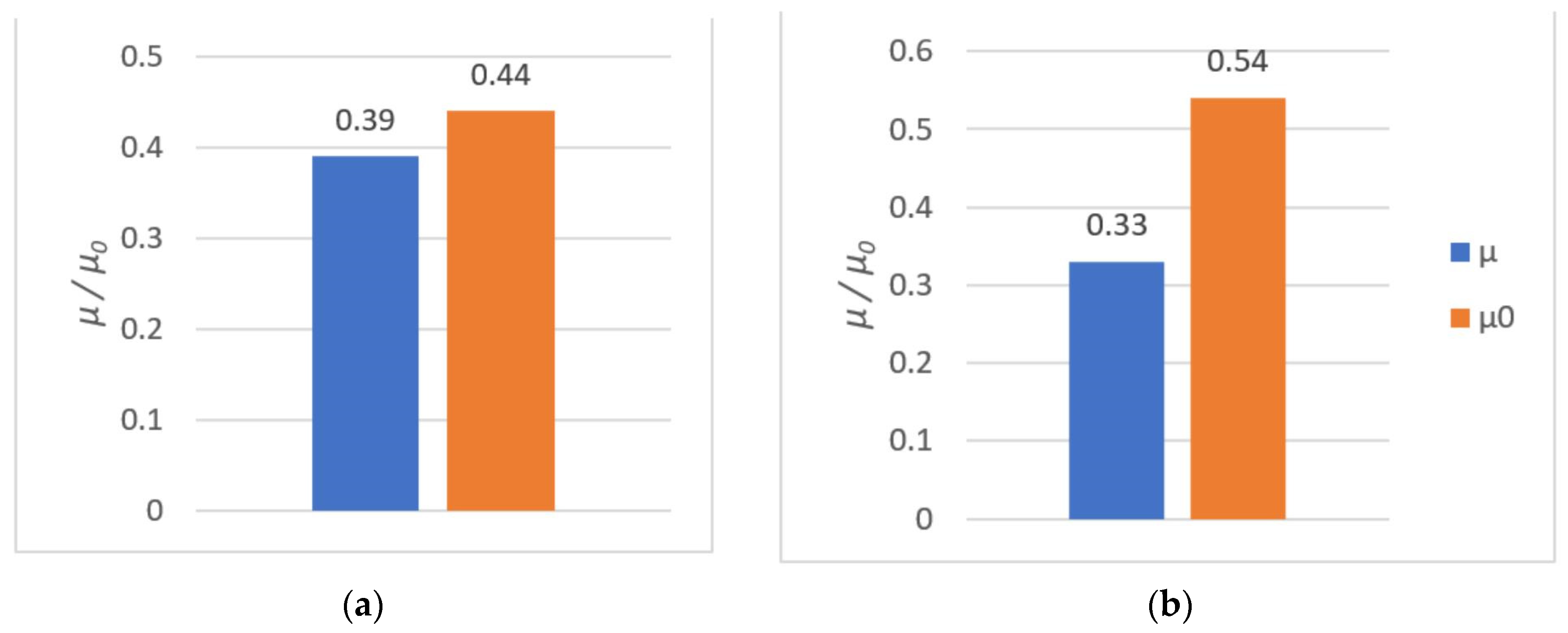
| Properties | Test Method | Z-PLA | Z-Nylon |
|---|---|---|---|
| Tensile Strength | ISO 527:1998 | 47.95 MPa | 33.22 Mpa |
| Breaking Stress | ISO 527:1998 | 46.53 Mpa | 29.81 Mpa |
| Elongation at Max Tensile Stress | ISO 527:1998 | 3.80% | 9.17% |
| Elongation at Break | ISO 527:1998 | 4.32% | 23.62% |
| Bending Stress | ISO 178:2011 | 56.80 Mpa | 38.30 Mpa |
| Flexural Modulus | ISO 178:2011 | 1.47 Gpa | 781.01 Mpa |
| Izod Impact, Notched | ISO 180:2004 | 3.14 kJ/m2 | 12.81 kJ/m2 |
| Melt Flow Rate | ISO 1133:2006 | 14.48 g/10 min (Load 2.16 kg, Temperature 190 °C) | 9.23 g/10 min (Load 5.00 kg Temperature 235 °C) |
| Specific Density | ISO 1183-3:2003 | 1.292 g/cm3 | 1.027 g/cm3 |
| Shore Hardness (D) | ISO 868:1998 | 79.8 | 62.0 |
| Roughness Parameter | Value for the Sample with Lower Roughness (µm) | Value for the Sample with Higher Roughness (µm) |
|---|---|---|
| Ra | 0.37 | 6.2 |
| Rz | 2.6 | 36.5 |
| Deposited Plastic | PLA | PA |
|---|---|---|
| Metal on which plastic is deposited | Ti6Al4V titanium alloy | |
| Metal temperature during deposition of the first three layers of plastic | 220 °C | 260 °C |
| Metal temperature during deposition of the fourth and subsequent layers of plastic | 60 °C | 160 °C |
| Temperature of the deposited plastic | 220 °C | 260 °C |
| 3D printing nozzle diameter | 0.4 mm | |
| Layer height | 0.2 mm | |
| Infill density and infill pattern | 90% (the infill lines printed at a 45° angle) | |
| First layer print speed | Reduced (50%) | |
| First layer flow ratio | Normal (100%) | |
| First layer density | Normal (100%) | |
| Material | Type of Load | Stress at Rupture of the Bond [MPa] | |
|---|---|---|---|
| Metal Specimen with Lower Roughness | Metal Specimen with Higher Roughness | ||
| PLA | Tension | 1.84 ± 0.50 | 3.47 ± 1.91 |
| Shear | 1.13 ± 0.34 | 1.00 ± 0.14 | |
| PA | Tension | 0.42 ± 0.18 | 0.05 ± 0.01 |
| Shear | 0.43 ± 0.18 | 0.02 ± 0.01 | |
| Tribological Pair | Dry Friction | Friction in the Presence of Water | ||
|---|---|---|---|---|
| µ | µ0 | µ | µ0 | |
| PLA–Ti6Al4V | 0.59 | 0.62 | 0.36 | 0.52 |
| PA–Ti6Al4V | 0.18 | 0.19 | 0.15 | 0.15 |
| Ti6Al4V–Ti6Al4V | 0.39 | 0.44 | 0.33 | 0.54 |
Publisher’s Note: MDPI stays neutral with regard to jurisdictional claims in published maps and institutional affiliations. |
© 2022 by the authors. Licensee MDPI, Basel, Switzerland. This article is an open access article distributed under the terms and conditions of the Creative Commons Attribution (CC BY) license (https://creativecommons.org/licenses/by/4.0/).
Share and Cite
Grygier, D.; Kujawa, M.; Kowalewski, P. Deposition of Biocompatible Polymers by 3D Printing (FDM) on Titanium Alloy. Polymers 2022, 14, 235. https://doi.org/10.3390/polym14020235
Grygier D, Kujawa M, Kowalewski P. Deposition of Biocompatible Polymers by 3D Printing (FDM) on Titanium Alloy. Polymers. 2022; 14(2):235. https://doi.org/10.3390/polym14020235
Chicago/Turabian StyleGrygier, Dominika, Maciej Kujawa, and Piotr Kowalewski. 2022. "Deposition of Biocompatible Polymers by 3D Printing (FDM) on Titanium Alloy" Polymers 14, no. 2: 235. https://doi.org/10.3390/polym14020235
APA StyleGrygier, D., Kujawa, M., & Kowalewski, P. (2022). Deposition of Biocompatible Polymers by 3D Printing (FDM) on Titanium Alloy. Polymers, 14(2), 235. https://doi.org/10.3390/polym14020235








